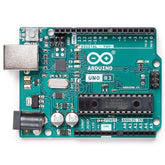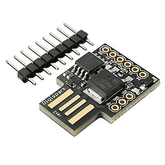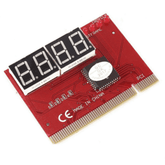Arduino Uno Pin Diagram: A Complete Guide
Summary
Curious about what the Arduino Uno can do? Check out our blog for more details! Join our interactive course, which will take you from a fundamental understanding of the Arduino Uno and its pin diagram to grasping its functionality.
Explore the various uses for digital, analog, power, and other critical pins to uncover the unlimited possibilities for your designs. This book is packed with useful information for both new and seasoned fans.
Don't pass up this opportunity to improve your Arduino projects. Explore the tutorial now and take your work to the next level!
Introduction
It is a comprehensive guide for understanding the various types of pins found on an Arduino board.
For makers, hobbyists, and professionals alike, this diagram provides helpful visuals to enable us to understand the purpose of each pin in regards to its function when connected with other components.
With easy-to-follow instructions and diagrams that provide clear examples, we are able to confidently utilize our boards correctly so as not to risk any damage or malfunctioning issues.
From powering up projects through USB connectors onto specific digital input/output connections, using these images can save time while ensuring reliable outcomes every step along your journey!
What is the Arduino Uno?

The Arduino Uno board is highly versatile; it enables hardware developers to create digital electronic projects with ease, even with minimal coding experience. It is very useful for the people who are interested in electronics or robotics, if they are professionals or hobbyists.
At its core, It comprises of both analog and digital ports that are compatible with any external components such as sensors, switches, push-buttons, or even LED lights without requiring additional circuitry.
The user can program the device using either custom code written on the computer via USB connection or use preloaded examples, which make programming much easier if you have no prior knowledge.
Furthermore, one unique advantage offered by this platform is its wide range of third-party modules, which allows users to extend their project capabilities beyond what’s available directly out-of-the-box, ranging from wireless communication protocols like Bluetooth Low Energy to image processing systems like OpenCV.
With each module able to be connected directly into their design through standard interface pins, expanding your project possibilities is endless!
Overall, it’s easy to see why so many people choose the Arduino Uno when starting new development cycles thanks largely to how accessible and intuitive it makes creating complex circuits, making sure everyone has equal chances at getting into embedded development regardless of technical background level.
read more : What is the microcontroller used in Arduino UNO?
The Arduino Uno Pin Diagram
The pin diagram is a visual representation of the pins on the board. It shows the location and function of each pin, making it easy to understand how the board works. The Arduino Uno board has 14 digital I/O pins, 6 analog pins, 4 power pins, 1 reset pin, and an ICSP header. Here is a breakdown of the Arduino Uno pinout:

Digital Pins
The Arduino Uno has 14 digital input/output pins, labeled 0 through 13. These pins can be used for a variety of purposes, including reading sensors, controlling LEDs, and driving motors. Here is a breakdown of what each digital pin does:
Digital Pin 0 (RX):
Think of this pin as the receiver of messages. It's like your Arduino's ears, listening for data from other devices or even your computer. It's great for getting information from the outside world.
Digital Pin 1 (TX):
This is the talker of the bunch. It's like your Arduino's mouth, sending out messages to other devices or your computer. It's useful when you want your Arduino to share information with the world.
Digital Pins 2-13:
These are the versatile ones. They can be used to both control things and sense things. Imagine them as switches that can be turned on (HIGH) or off (LOW). You can use them to make LEDs blink, control motors, or even read signals from buttons or sensors.
Digital Pin 13 (LED):
This pin is special because it's already connected to a tiny built-in LED on the Arduino board. It's like a tiny little test buddy. You can use it to check if your Arduino is in good spirits and doing its job.
PWM (Pulse Width Modulation):
Some of these pins (usually 3, 5, 6, 9, 10, and 11) can do a cool trick. They can flicker really fast between bright and dim, kind of like pretending to be sort-of analog. This is nifty when you want to control stuff like making a light smoothly fade in and out.
Interrupts:
Think of these pins as the "Hey, pay attention!" crew. They tap your Arduino on the shoulder when something important happens, like a change in a sensor or a button being pressed. It's like having a friend who grabs your attention when something interesting is going on.
By getting to know these digital pins, you're opening the door to a whole bunch of creative projects. You can make your Arduino listen, talk, blink, and respond to the world around it in all sorts of imaginative ways!
read more : What is Arduino UNO
Analog Pins
Analog pins of the Arduino Uno are used to connect analog sensors and signals. Analog pins can measure a wide range of voltage levels, as opposed to digital pins, which can only function in high or low states.
This makes them ideal for use with sensors that produce analog signals, such as light sensors, temperature sensors, and potentiometers, among others.
It includes six analog input pins designated A0 through A5. These pins may monitor analog voltages ranging from 0 to 5 volts.
The resolution of analog pins is expressed in bits. The Arduino Uno's analog pins can monitor analog voltage levels in 1024 steps, with a 10-bit resolution.
Here's a breakdown of the analog pins:
Analog Pin A0:
This pin can read an analog voltage and convert it into a digital value. The resolution of 10 bits means it can distinguish between 1024 different voltage levels between 0 and 5 volts.
Analog Pin A1:
Similar to A0, this pin also has a resolution of 10 bits and can read analog signals in the same manner.
Analog Pin A2:
Just like A0 and A1, A2 can read analog signals with a resolution of 10 bits.
Analog Pin A3:
This pin functions in the same way as the others, with a 10-bit resolution for reading analog voltages.
Analog Pin A4:
Again, this pin serves the same purpose as the rest, allowing for the reading of analog voltages with a resolution of 10 bits.
Analog Pin A5:
Similarly to the other analog pins, A5 can read analog signals with a resolution of 10 bits.
read more: Arduino Pin Configuration
Power Pins
The Arduino Uno has several power pins that are used to power the board and other devices. Here is a breakdown of what each power pin does:
5V Pin:
This pin provides a regulated 5V DC output. It can be used to power other devices that require 5V DC.
3.3V Pin:
This pin provides a regulated 3.3V DC output. It can be used to power other devices that require 3.3V DC.
GND Pins:
These pins are used to connect the board to ground. They can be used to complete circuits and provide a reference voltage.
VIN Pin:
This pin is used to power the board using an external power source. It can accept a voltage between 7V and 12V DC.
read more : Which Arduino Board to Buy
Other Pins
The Arduino Uno has several other pins that are used for specific purposes. Here is a breakdown of what each pin does:
Reset Pin:
This pin is used to reset the board. When the pin is set to LOW, the board is reset.
ICSP Header:
This header is used to program the board using an external programmer.
USB Connection: This connection is used to program the board and communicate with other devices.
read more : Arduino Hacks we bet you did not know!
Conclusion
For those who are new to Arduino, the pin diagram of the Arduino Uno is an essential tool. It provides insightful advice and recommendations for developing cutting-edge initiatives like robotics and Internet of Things apps.
The basic layout makes it simple to add new components or improve old circuits, even if you're not an electrical engineering specialist.
Our tutorial is aimed to help you get the most out of your Arduino projects. It gives a comprehensive resource for learning how to utilize the pins securely and efficiently, allowing you to elevate your projects to the next level!
If you appreciate our work don't forget to share this post and leave your opinion in the comment box.
Please do check out other blog posts about Popular electronics
Make sure you check out our wide range of products and collections (we offer some exciting deals!)
Excerpt
Frequently Asked Questions
1. What are the pins in Arduino Uno?
The Arduino Uno stands as a prevalent microcontroller board, featuring designated pins that encompass diverse functionalities. Presented below is an overview of the Arduino Uno's pins:
- Digital Pins (D0-D13): These pins serve as dual-purpose interfaces for both digital input and output. Notably, pins D3, D5, D6, D9, D10, and D11 possess the capability to generate Pulse Width Modulation (PWM) signals, facilitating emulation of analog-like output.
- Analog Pins (A0-A5): These pins specialize in analog input, enabling the acquisition of analog data from sensors and analogous devices.
- Power Pins: This category encompasses:
Vin: Functioning as the input voltage pin, it accommodates an external supply voltage within specified limits.
5V: Emitting a steady 5V output, this pin fuels external components.
3.3V: This pin yields a regulated 3.3V output.
GND: Serving as the ground reference for the board. - Reset Button: Employ this button to initiate a microcontroller reset.
- ICSP Header: The In-Circuit Serial Programming header serves the purpose of externally programming the microcontroller.
- USB Connection: The USB port establishes a communication bridge between the board and your computer, doubling as a power source for the board.
- Power Jack: This jack offers an alternative power input source. You can supply power through this port using a suitable adapter.
These pins deliver a wide spectrum of potentialities, enabling interactions with various electronic components, sensors, actuators, and beyond. The Arduino Uno's pin configuration culminates in an adaptable platform, ideally suited for the creation of interactive ventures and prototypes.
read more : Interfacing GPS Module with Arduino
2. What are two main types of Arduino pins?
These are two main types of Arduino pins:
- Digital Pins: These versatile pins accommodate both input and output tasks involving digital signals. They function through two distinct voltage levels: HIGH (typically 5V or 3.3V) and LOW (0V). Common applications encompass activities like toggling LEDs, ascertaining switch states, and establishing connections with digital apparatus.
- Analog Pins: Designed primarily for deciphering analog signals sourced from sensors or devices, analog pins exhibit a unique trait. Unlike digital counterparts that embody binary states, analog pins adeptly traverse a continuous spectrum of voltage levels. This attribute proves invaluable when interfacing with sensors yielding analog outputs – examples include light sensors, temperature gauges, and potentiometers.
read more : Exploring LCD Displays and Arduino UNO
3. What is the difference between digital and analog pins on the Arduino Uno?
The Arduino Uno board has both digital and analog pins, each serving a distinct purpose:
Digital Pins:
- Digital pins are used for both input and output operations with digital signals.
- They can be set to two discrete states: HIGH (usually 5V or 3.3V) and LOW (0V).
- Digital pins can be used to send and receive binary signals, making them suitable for tasks requiring on/off or true/false conditions.
Analog Pins:
- Analog pins are primarily used for reading analog signals from sensors or devices.
- They can read a continuous range of voltage levels, typically ranging from 0V to the board's operating voltage (5V or 3.3V).
- The Arduino's analog pins convert the continuous voltage levels into digital values that can be processed by the microcontroller.
read more :Smart Security System
4. What are the 14 digital pins in Arduino?
The Arduino Uno R3 has 14 digital pins, labeled D0 to D13. These are used for digital input or output (i.e., HIGH or LOW).
Here’s a list of all 14 digital pins on the Arduino Uno and their key functions:
Pin Function(s) D0 RX (Serial Communication) D1 TX (Serial Communication) D2 External Interrupt (INT0) D3 PWM, External Interrupt (INT1) D4 Digital I/O D5 PWM D6 PWM D7 Digital I/O D8 Digital I/O D9 PWM D10 PWM, SPI (SS - Slave Select) D11 PWM, SPI (MOSI - COPI) D12 SPI (MISO - CIPO) D13 SPI (SCK), Onboard LED (LED_BUILTIN)
Note: Pins D3, D5, D6, D9, D10, and D11 support PWM output (analogWrite() function), which is useful for dimming LEDs or controlling motor speeds.
Vin: Functioning as the input voltage pin, it accommodates an external supply voltage within specified limits.
5V: Emitting a steady 5V output, this pin fuels external components.
3.3V: This pin yields a regulated 3.3V output.
GND: Serving as the ground reference for the board.
| Pin | Function(s) |
|---|---|
| D0 | RX (Serial Communication) |
| D1 | TX (Serial Communication) |
| D2 | External Interrupt (INT0) |
| D3 | PWM, External Interrupt (INT1) |
| D4 | Digital I/O |
| D5 | PWM |
| D6 | PWM |
| D7 | Digital I/O |
| D8 | Digital I/O |
| D9 | PWM |
| D10 | PWM, SPI (SS - Slave Select) |
| D11 | PWM, SPI (MOSI - COPI) |
| D12 | SPI (MISO - CIPO) |
| D13 | SPI (SCK), Onboard LED (LED_BUILTIN) |








